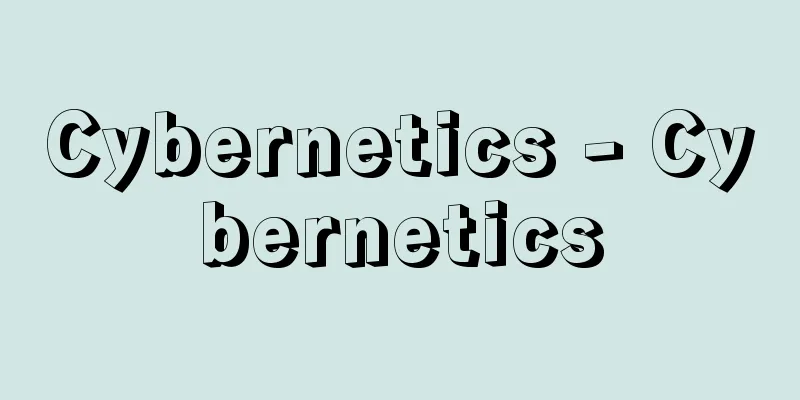Cybernetics - Cybernetics

|
A scientific theory proposed by the American mathematician Wiener in Cybernetics: Control and Communication in Animals and Machines (1948). As indicated in the subtitle of the book, it starts from the parallelism and isomorphism between the behavior of individual organisms and the operation of communication machines, and aims to study the control and communication/information transmission structures in mechanical systems, biological systems, and social organizations from a fundamentally uniform methodological perspective. [Arakawa Hiroshi] The Establishment of CyberneticsIf we were to name the biggest factor that characterizes the development of modern science and technology in the second half of the 20th century, it would be the progress of electronics and the emergence of the electronic calculator (computer). Along with the invention of the transistor by Shockley and others, the beginning of the modern era in this sense is marked by Wiener's proposal of "cybernetics" and Shannon's announcement of "information theory" in the same year, and around the same time, von Neumann's proposal of a stored-program method for digital computing machines. These three scientists, Wiener, Shannon, and von Neumann, are known as the founders of information science, which continues to this day. Wiener's proposal of cybernetics is considered the starting point of that trend, and the theory of control and prediction contained in it has become one of the basic lines of the comprehensive development of information science to this day. The late 1940s was an important turning point in the above sense, but its premise was the development of communications engineering and technology, which began with Marconi's successful wireless telegraphy experiments at the end of the 19th century and the invention of the vacuum tube at the beginning of the 20th century (especially de Forest's invention of the triode vacuum tube in 1907). The purpose of communications technology is to send messages correctly. When communications engineering is viewed from this perspective, the issue is the "amount of information" contained in the message. In this case, the amount of information obtained from one binary choice is considered the unit of information amount. Information theory based on this approach was constructed by Shannon, Wiener, and others in the 1930s and 1940s. Shannon began this type of research at roughly the same time, starting with the problem of encoding information, while Wiener began with the problem of separating noise and messages using electrical filters. In the 1930s, long-distance multiplex communication was an issue in communication engineering, and amplifiers with small nonlinear distortion were required. Black's invention of the negative feedback amplifier circuit met this need. Thus, the theory of negative feedback in the field of wire communication engineering made remarkable progress in the 1930s. This theory can be applied to automatic control theory, and began to be taken up in that field around 1940. During World War II, Wiener conducted research related to the automation of anti-aircraft gun aiming, and this is described as a theory of prediction and filtering in Chapter 3, "Time Series, Information, and Communication," of the aforementioned Cybernetics. The most important point in which Wiener took a step forward from previous control theory was that he viewed control as essentially an information problem. Observations are always subject to noise (errors), making information incomplete, and his concern was how to estimate true values as accurately as possible from such data, which resulted in the theory of prediction. His previous mathematical research on Brownian motion was a direct premise for this. The Brownian motion theory has the same structure as the electrical noise theory and is fundamentally related to the problem of filters and prediction theory. Wiener, through experimental research on biological control conducted jointly with his friend Arturo Rosenblueth (1900-1970), then director of the Mexican National Institute of Cardiology, and others, came to the viewpoint of considering various control mechanisms in living organisms on the same level as control in artificial machines. They had already realized in the early 1940s that "a series of problems centered on communication, control, and statistical mechanics can be essentially unified, whether they concern machines or living tissues." This is also indicated and emphasized in the subtitle of his book Cybernetics. Thus, Wiener constructed his theory of information, communication, control, and prediction, and considered the problems of biological and nervous systems as "sensibility to stimuli belongs to the realm of communication theory," and further entered the realm of psychology and language theory, consolidating all of the above into a single system, which he presented to the world in the book mentioned at the beginning. He said: "Suppose there are two variables in our situation, one of which is beyond our control and the other which we can adjust. We then hope to determine appropriate values for the adjustable variable based on the past and present values of the uncontrollable variable, in order to bring about the most convenient situation for us. Cybernetics is none other than the method for achieving this" (Preface to the Japanese edition of "Cybernetics"). [Arakawa Hiroshi] The development of cybernetics and information science and its social significanceInformation science, whose development was opened by Wiener, Shannon, von Neumann and others in the late 1940s and 1950s, has made astonishing progress in the half century since then. Today, the main part of what is called information science is the development of digital computing machines, and the biggest direct impetus for this was the introduction of von Neumann's stored-program method. It can be said that the main field is the science of "information machines" (communication machines, computing machines, automatic control machines). The basic ideas that Wiener intended have been developed as part of the development of information science, and today they have become the very content of information science itself. If we take a somewhat broader view of information science, we can say that its comprehensive development today is the development of what he intended when he proposed cybernetics. In that sense, Wiener's ideas and intentions have been realized to this day. What is the unique significance of cybernetics today? It is in Wiener's original concept itself. He regarded the living body as an automatic machine and applied the theory of automatic control. This promoted research into the functioning of the human brain. Today, this is also the subject of information science, and its elucidation is considered to be its final goal. On the other hand, this point had a great influence on completely different academic fields, such as philosophy. This is particularly noticeable in the field of epistemology. Epistemology research that incorporates cybernetics methods has progressed, mainly in Eastern European countries, and Wiener's concept itself has been evaluated, incorporated, and combined with Pavlov's conditioned reflex theory to form a materialistic epistemology as a theory of reflection. Furthermore, the contribution of the cybernetic perspective to the field of psychology in general will continue to be made clear in the future. Of course, it is clearly wrong to overemphasize its significance formally and to equate human intelligence with cybernetic organizations. In fields such as linguistics, the pursuit and exploration of the effectiveness of cybernetic ideas will likely continue to expand beyond the boundaries of information science in the narrow sense. Wiener's ideas, at their very foundation, will continue to have a wide-ranging impact on society and raise new issues for the future. [Arakawa Hiroshi] Science of Information SystemsBoth living things and machines are systems designed to achieve a certain goal, and while taking action to achieve that goal, the system constantly predicts or provides feedback on the results of those actions to prepare for the next action, and takes the optimal action to achieve that goal. In other words, both living things and machines are equipped with special devices that collect information from the outside world and use it to aid in their own actions, and these devices convert the information into a new form that is useful for subsequent actions, thereby enabling them to take actions effectively in the outside world. And the actions actually performed in the outside world also provide information to the devices. In this way, both living things and machines self-regulate to take the optimal action to achieve their goals while responding to their relationship with the outside world. This process of self-control can be commonly recognized regardless of the type of living organism or machine, or the differences between living organisms and machines, when they are considered as a system, and the structure, function, and development of such a system can generally be understood in terms of the transmission, processing, and storage of information. This also applies to human society. From this perspective, the basic task of cybernetics is to focus on the process of self-control in living organisms, machines, and society, to theoretically study the general laws concerning the structure and function of control systems, and to develop management and control technologies for living organisms, machines, and society from that perspective. It is also called the "general theory of information and control" or the "science of information systems." [Akihiro Ishikawa] Introduction to the Analysis of Human SocietyThe basic concept of cybernetics was elaborated through discussions among researchers from various fields, especially mathematicians, medical scientists, and physicists, led by Wiener and Rosenbluth. As Wiener developed the concept from a simple theory of motion control into a more general theory, it had a great influence as a comprehensive scientific methodology not only on the fields of natural sciences and engineering, but also on social sciences and even philosophy and thought. Today, in addition to cybernetics as a general theory, engineering cybernetics, biological cybernetics, medical cybernetics, psychological cybernetics, economic cybernetics, and management cybernetics, which are linked to individual sciences, have developed. The study of economics and management has been the field that has most extensively adopted the perspective of cybernetic theory in the analysis of human society. Economics has developed economic cybernetics in an attempt to more accurately model and analyze the decision-making mechanisms in national economies or companies. Its central theme is the analysis of decision-making structures and information exchange in socio-economy, and this research was particularly carried out in the context of optimizing planned economies in the former Soviet Union and Eastern Europe during the socialist era. Management cybernetics has also developed in an attempt to model the management and organizational processes in corporations from the perspective of information and control. Furthermore, if we consider cybernetics in the context of social thought, Wiener himself, in his reflections on human society, criticized the form of social organization in which those in power unilaterally issue orders from the top down to move people, calling it an affront to humanity, and he put forward a theory of democratic society while emphasizing the importance of information feedback. [Akihiro Ishikawa] "The Brain and the Mind" by Rosenbluth, translated by Kuroda Yoichiro (1976, Misuzu Shobo) ▽ "The Human Machine: The Human Use of Humans" by N. Wiener, translated by Chinme Yasuo and Ikehara Togao (1979, Misuzu Shobo) ▽ "Cybernetics: Control and Communication in Animals and Machines, 2nd Edition, by N. Wiener, translated by Ikehara Togao et al. (1984, Iwanami Shoten)" ▽ "Iwanami Lectures on Information Science 1: The Progress of Information Science" by Takahashi Hidetoshi (1984, Iwanami Shoten) ▽ "Cybernetics and Learning Theory: An Attempt at Education" by Felix von Kube, translated by Inoue Tan and Esswein Mikiko (1987, Toyokan Publishing) ▽ "Bio-Cybernetics" 1 and 2 by Hatakeyama Ippei (1989, Asakura Shoten) ▽ "Psychological Cybernetics Series 2: The Path to Self-Transformation" by Paul G. Thomas, translated by Toshima Yozo (1991, Nakanishiya Publishing)" ▽ "Information Engineering and Control Theory" by Okada Yoshitomo (1995, Senbundo)" ▽ "Cybernetic Renaissance: Escaping the Closed State of Knowledge" edited by Ishikawa Akira, Okuyama Makiko, and Kobayashi Toshitaka (1999, Industrial Research Institute)" ▽ "Cyberneticists: The Beginnings of Postwar Science in America" by Steve J. Himes, translated by Tadahira Miyuki (2001, Asahi Shimbun)" ▽ "How Cybernetics Came About" by N. Wiener, translated by Chinme Yasuo, new edition (2002, Misuzu Shobo)" ▽ "The Political Theory of Cybernetics" by K.W. Deutsch, translated by Shigeyuki Ito, Keizo Sato, Iwao Takayama, Etsushi Tanito, and Yuzo Yabuno, New Edition (2002, Waseda University Press) [References] | | | | | | | | | | | | | | |Source: Shogakukan Encyclopedia Nipponica About Encyclopedia Nipponica Information | Legend |
|
アメリカの数学者ウィーナーが『サイバネティックス――動物と機械における制御と通信』(1948)で提起した科学理論。それは、著書の副題に示されているように、生物個体の行動と通信機械の動作の平行性、同型性から出発して、広く機械系、生体系、社会組織における制御と通信・情報伝達の構造を、基本的に同一の方法的視点で研究しようとするものである。 [荒川 泓] サイバネティックスの成立20世紀後半の現代科学・技術の発展を特徴づける最大の要因をあげるとすれば、それはエレクトロニクスの進歩、電子計算機(コンピュータ)の登場ということになろう。ショックレーらによるトランジスタの発明などとともに、この意味での現代の始まりのところに位置しているのが、ウィーナーの「サイバネティックス」の提起と同年のシャノンの「情報理論」の発表であり、相前後してほぼ同時期になされた、フォン・ノイマンによるデジタル計算機械のプログラム内蔵方式の提案である。このウィーナー、シャノン、フォン・ノイマンの3人の科学者は、今日に至る情報科学の創設者として、その名があげられることになる。ウィーナーによるサイバネティックスの提唱は、その流れの出発点に位置づけられ、その内容に含まれる制御・予測の理論は、今日に至る情報科学の全面的展開の基本路線の一つとなってきた。 1940年代末の時期は以上の意味で重要な画期となるが、その前提をなすのが、19世紀末、マルコーニによる無線電信実験の成功、20世紀当初の真空管の発明(とくにド・フォレストの三極真空管の発明、1907)などに始まる通信工学・技術の発展である。通信技術の目的は通信文(メッセージ)を正しく送ることである。通信工学をこの立場からとらえるとき、通信文に含まれる「情報量」が問題となる。その場合、1回の二者択一で得られる情報の量を情報量の単位とする。1930~1940年代にシャノン、ウィーナーらにより、こうした考え方での情報の理論が構成された。シャノンは情報の符号化の問題から、ウィーナーは電気濾波(ろは)器(フィルター)による雑音と通報の分離の問題から、ほぼ同時期にこのような研究に入っていった。 1930年代の通信工学では長距離多重通信が課題となっており、そこでは非直線ひずみの小さい増幅器が要求されていた。ブラックによる負帰還(負のフィードバック)増幅回路の発明はそれにこたえるものであった。かくして有線通信工学分野で負帰還の理論は1930年代に著しく発展した。この理論は自動制御理論に応用できるものであり、1940年前後からその立場で取り上げられ始めていた。ウィーナーは第二次世界大戦中、高射砲の照準の自動化などに関連して研究を進め、それは予測とフィルターに関する理論として前記『サイバネティックス』第3章「時系列、情報および通信」に述べられている。ウィーナーがそれまでの制御理論から歩を進めたもっとも重要な点は、制御を本質的に情報の問題としてとらえたところにある。観測にはかならず雑音(誤差)が入り、情報は不完全なものとなり、そうしたデータからできるだけ正しく真の値を推定するにはどうすればよいか、というのが彼の問題意識であり、それが予測理論として結実したのである。彼がそれ以前にブラウン運動の数学的研究を進めていたことはその直接の前提となった。ブラウン運動理論は電気雑音理論と同一の構造であり、フィルターの問題、予測理論と基本的にかかわる。 ウィーナーは、その友人であるメキシコ国立心臓学研究所長(当時)のローゼンブリュートArturo Rosenblueth(1900―1970)らとの共同で進めた生体制御に関する実験的研究を経て、生体内各種制御機構を人工の機械における制御と同じレベルでとらえるという観点にたっていた。彼らは「通信と制御と統計力学を中心とする一連の問題が、それが機械であろうと、生体組織のことであろうと、本質的に統一されうるものであること」にすでに1940年代前半に気づいていた。これは、著書『サイバネティックス』の副題にも示され、強調されているところである。かくしてウィーナーは、その情報・通信と制御・予測の理論を組み立て、生体系・神経系の問題を「刺激に対する感受性は通信理論の領域に属する」ものととらえ、さらに心理学、言語理論の領域に立ち入り、以上を一つの体系にまとめて、冒頭にあげた著書として世に問うたのである。彼はいう。「われわれの状況に関する二つの変量があるものとして、その一方はわれわれには制御できないもの、他の一方はわれわれに調節できるものであるとしよう。そのとき制御できない変量の過去から現在に至るまでの値にもとづいて、調節できる変量の値を適当に定め、われわれにもっともつごうのよい状況をもたらせたいという望みがもたれる。それを達成する方法がサイバネティックスにほかならない」(『サイバネティックス』日本版への序文)。 [荒川 泓] サイバネティックス・情報科学の発展とその社会的意義1940年代後半から1950年代にかけてウィーナー、シャノン、フォン・ノイマンらによってその発展への扉を開かれた情報科学は、その後約半世紀の間に驚くべき長足の進歩を遂げた。今日、情報科学といわれているものの主体をなすのはデジタル計算機械の研究からの発展であり、その直接の最大の契機となったのはノイマンのプログラム内蔵方式の導入であった。この主流をなす領域は「情報機械」(通信機械、計算機械、自動制御機械)の科学であるといってよい。ウィーナーの意図したところの基本は、この情報科学の展開のなかに含まれた形で発展させられ、今日では、まさに情報科学そのものの内容となってきている。そして情報科学をやや広くとらえた場合、その今日における全面的展開は、彼がサイバネティックスの提唱で意図したことそのものの発展であるともいえよう。その意味で、ウィーナーの理念と意図は実現され今日に至っている。 そのうえで、サイバネティックス独自の今日における意義は何であろうか。それはウィーナーの当初の理念そのもののなかにある。彼は生体を自動機械とみなし、自動制御の理論を適用した。それは人間の脳の働きの問題の研究を促進した。これも今日では情報科学の対象であり、その解明はその最終目標とされる。一方この点は、まったく別の学問領域、たとえば哲学の分野に大きな影響を与えた。それは認識論領域において著しい。東ヨーロッパ諸国を中心に、サイバネティックスの方法を取り入れた形での認識論研究が進み、ウィーナーの理念そのものを評価し、それを取り込み、パブロフの条件反射理論などと結合して、反映論としての唯物論的認識論の構成がなされた。さらに、心理学分野一般へのサイバネティックス的視点の貢献は、今後も明らかにされてゆくことであろう。もちろん、その意義が形式的に強調されすぎ、人間の知性をサイバネティックス組織と同一視するのは明らかに誤っている。言語学の分野などでも、狭義の情報科学の枠を越えたところで、サイバネティックス的理念の有効性の追求、その模索は今後もいっそうの広がりをみせて進められてゆくものと思われる。ウィーナーの理念はその基本のところで将来に向かって広く社会に影響を与え、問題を提起してゆくであろう。 [荒川 泓] 情報システムの科学生物も機械もある目的を達成するために構成されたシステムであり、そのシステムは目的達成のための行動をとりながら、絶えずその行動結果を予想あるいはフィードバックして次の行動を準備し、目的達成にとって最適な行動を行っていく。つまり、生物も機械も外界から情報を集め、それを自らの行動に役だてるための特殊な装置を備えており、その装置は情報をその後の行動に役だつように新しい形に変換して取り入れ、それによって行動を外界に対して効果的に行うようにする。そして、実際に外界に対して行われた動作がまたその装置に情報をもたらす。こうして生物も機械も外界との関係に対応しながら目的達成のための最適行動をとるように自己制御している。 このような自己制御の過程は、生物や機械の種類のいかんにかかわりなく、また生物と機械の違いにもかかわりなく、それらをシステムとしてとらえたときには共通に認識できるものであり、そのシステムの構造と機能と発展は、情報の伝達・処理・貯蔵という面から一般にとらえることができる。このことは人間社会にも当てはまる。このような観点から生物・機械・社会における自己制御の過程に注目して制御システムの構造と機能に関する一般的な法則を理論的に研究し、またその観点から生物・機械・社会の管理と制御の技術を開発していくこと、これがサイバネティックスの基本課題とされる。それはまた「情報と制御の一般理論」とか「情報システムの科学」ともいわれる。 [石川晃弘] 人間社会の分析への導入ウィーナーとローゼンブリュートを中心に進められた諸分野の研究者の討論、とくに数学者、医学者、物理学者らの議論のなかからサイバネティックスの基本概念が練り上げられていった。その構想がウィーナーによって、単なる運動制御の理論から、より一般的な理論へと発展させられるなかで、それは総合的な科学方法論として、自然諸科学や工学の分野のみならず、社会諸科学、さらには哲学や思想の分野にも大きな影響を及ぼした。そして今日では、一般理論としてのサイバネティックスとともに、個別諸科学と結び付いた工学サイバネティックス、生物サイバネティックス、医学サイバネティックス、心理サイバネティックス、経済サイバネティックス、経営サイバネティックスなどが発達している。 サイバネティックスの視点を人間社会の分析にもっとも大きく取り入れてきたのは経済・経営の研究である。経済学は、国民経済あるいは企業における意思決定メカニズムをより正確にモデル分析しようとして、経済サイバネティックスを発達させた。その中心課題は社会経済における意思決定構造と情報交流の分析に置かれ、とくにその研究は社会主義時代の旧ソ連・東欧で計画経済の最適化という文脈で展開された。また、企業体における管理と組織の諸過程を情報と制御という観点からモデル化しようとして、経営サイバネティックスも発展してきた。さらに、社会思想の文脈でサイバネティックスをとらえるならば、ウィーナー自身がその人間社会の省察のなかで、権力者が上から下に一方的に命令を下して人々を動かすような社会組織のあり方を人間に対する冒涜(ぼうとく)だとして批判し、情報のフィードバックの意義を強調しながら民主主義的社会理論を提起している。 [石川晃弘] 『ローゼンブリュート著、黒田洋一郎訳『脳と心』(1976・みすず書房)』▽『N・ウィーナー著、鎮目恭夫・池原止戈夫訳『人間機械論――人間の人間的な利用』(1979・みすず書房)』▽『N・ウィーナー著、池原止戈夫ほか訳『サイバネティックス――動物と機械における制御と通信』第2版(1984・岩波書店)』▽『高橋秀俊著『岩波講座 情報科学1 情報科学の歩み』(1984・岩波書店)』▽『フェリックス・フォン・クーベ著、井上坦・エスヴァイン三貴子訳『サイバネティックスと学習理論――教育への一つの試み』(1987・東洋館出版社)』▽『畠山一平著『生物サイバネティクス』1・2(1989・朝倉書店)』▽『ポール・G・トマス著、十島雍蔵訳『心理サイバネティクス・シリーズ2 自己変革への道』(1991・ナカニシヤ出版)』▽『岡田良知著『情報工学と制御理論』(1995・泉文堂)』▽『石川昭・奥山真紀子・小林敏孝編著『サイバネティック・ルネサンス――知の閉塞性からの脱却』(1999・工業調査会)』▽『スティーヴ・J・ハイムズ著、忠平美幸訳『サイバネティクス学者たち――アメリカ戦後科学の出発』(2001・朝日新聞社)』▽『N・ウィーナー著、鎮目恭夫訳『サイバネティックスはいかにして生まれたか』新装版(2002・みすず書房)』▽『K・W・ドイッチュ著、伊藤重行・佐藤敬三・高山巌・谷藤悦史・薮野祐三訳『サイバネティクスの政治理論』新装版(2002・早稲田大学出版部)』 [参照項目] | | | | | | | | | | | | | | |出典 小学館 日本大百科全書(ニッポニカ)日本大百科全書(ニッポニカ)について 情報 | 凡例 |
>>: Dismantling the Zaibatsu - I Want to Dismantle the Zaibatsu
Recommend
Kim Gu
Korean politician and independence movement leade...
Leningrad State University of Technology AAZhdanova (English: Leningrad State University of Technology AAZhdanova)
…University of the Russian Federation. Founded in...
Friendship Society - Yuaikai
The predecessor of the Japan General Federation o...
Child, Charles Manning
Born February 2, 1869 in Ypsilanti, Michigan. [Die...
Social Physical Education
A general term for physical education other than s...
Neorhodomela munita (English spelling)
…[Mitsuo Chihara]. . . *Some of the terminology e...
Piccard, Jacques
Born: July 28, 1922, Brussels, Belgium [Died] Nove...
LET effect
…LET values are large for charged particles wit...
Krasnyi internatsional profsoyuzov (English transcription) Krasnyi internatsional profsoyuzov
…the abbreviation for the Red Trade Union Interna...
Urabure - Urabure
...If an exile committed a bad act, he or she wou...
World Calendar - Sekaireki
A kind of solar calendar proposed by American bus...
Cleaver - Cleaver
An annual or biennial plant of the Rubiaceae fami...
Movement of hands - Unshin
A type of sewing technique that is the basis of h...
Grey-headed woodpecker (yamagera)
A bird of the woodpecker family, Picidae. A medium...
Heavenly shrine - Amatsuyashiro
In ancient times, this was a shrine that worshiped...


![Okagaki [town] - Okagaki](/upload/images/67cb193511015.webp)






